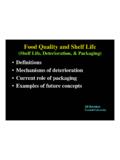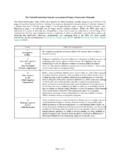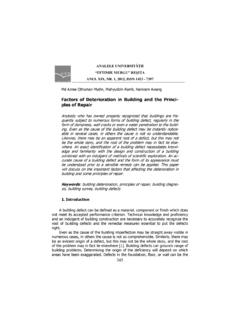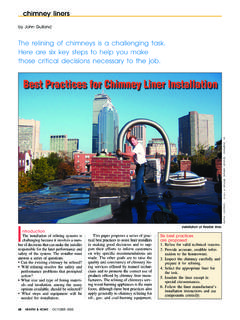Transcription of Overview on fish quality g, processing, storage and ...
1 Overview on fish quality research. Impact of fish handling, processing, storage and logistics on fish quality deterioration H l ne L. Lauzon Bj rn Margeirsson Kolbr n Sveinsd ttir Mar a Gu j nsd ttir Magnea G. Karlsd ttir Emil a Martinsd ttir N sk pun og neytendur Sk rsla Mat s 39-10. N vember 2010. ISSN 1670-7192. Titill / Title Overview on fish quality research - Impact of fish handling, processing, storage and logistics on fish quality deterioration H fundar / Authors H l ne L. Lauzon, Bj rn Margeirsson, Kolbr n Sveinsd ttir, Mar a Gu j nsd ttir, Magnea G. Karlsd ttir and Emil a Martinsd ttir Sk rsla / Report no. Mat s Report 39-10 tg fudagur / Date: November 2010. Verknr. / project no. 1704/1682. Styrktara ilar / funding: AVS R&D Fund of Ministry of Fisheries in Iceland, Technology Development Fund and EU IP Chill-on (contract FP6-016333-2). grip slensku: Stutt geymslu ol fisks er takmarkandi ttur tflutningi ferskra fiskafur a fr slandi.
2 Fjalla er um upphafsg i hr efnis, a fer ir vi . k lingu, vinnslu, p kkun og a st ur vi geymslu og flutning samt hrifum allra essara tta ferskleika og geymslu ol fiskafur a. Hitastigsst ring er mj g mikilv g til a vi halda g um fisks. Fork ling flaka vinnslu hefur veri notu til a l kka hitastig fyrir p kkun. Samt sem ur ver ur a g ta ess a t knin vi fork lingu stofni ekki rveru standi v runnar h ttu og ver i ar me til a h n skemmist fyrr eftir p kkun. Samverkandi hrif sem ver a af ofurk lingu og loftskiptri p kkun (MAP) geta lengt ferskleikat mabil og geymslu ol fiskafur a verulega. Ennfremur eru p kkunara fer ir sko a ar ar me al n jar umhverfisv nni pakkningar. A lokum er r tt um hrif flutningalei a ferskra fiskafur a lokag i eirra til neytenda marka i. Sk rsla essi veitir yfirs n yfir ranns knir Ranns knastofnunar fiski na arins og Mat s ohf s astli na rj ratugi vi fangsefninu. Ennfremur er r tt um hvernig essar ni urst ur geti n st fiski na inum.
3 Lykilor slensku: Fiskur Ferskleiki Geymslu ol - G i - K ling - Undirk ling - Vinnsla . P kkun - Flutningsferlar Hitastigsst ring Vir isauki Summary in English: The limited shelf life of fresh fish products is a large hurdle for the export of fresh products from Iceland. The influence of raw material quality , cooling methods, processing, packaging and storage conditions on freshness and shelf life extension is discussed. Temperature control is important to maintain fish quality . Pre-cooling of fillets in process has been used to lower the temperature prior to packaging. However, the cooling technique applied should not compromise the microbiological quality of the product and render it vulnerable to faster spoilage post- packaging. Synergism of combined superchilling and modified atmosphere packaging (MAP) can lead to a considerable extension of the freshness period and shelf life of fish products. Further, alternative and environmentally-friendly packaging methods are considered.
4 Finally, the impact of transportation mode of fresh fish products on their resulting quality is examined. This report provides an Overview of the findings on fish research carried out at Mat s (Icelandic Fisheries Laboratories) over the last three decades and further discusses their practicality for the fish processing industry. English keywords: fish - Freshness Shelf life - quality - Cooling - Superchilling - Processing - Packaging - Logistics - Temperature control Added value Copyright Mat s ohf / Matis - Food Research, Innovation & Safety Table of content 1 1. Introduction .. 7 2. Methods for assessing product freshness and shelf 9 3. Main research results .. 12 Freshness deterioration and sensory shelf life of whole, wild and farmed fish .. 12 Freshness deterioration and sensory shelf life of fish fillets .. 16 Raw material age of processed fresh products .. 16 Cooling methods of raw material on board and in process.
5 18 Brining of fillets and different processing/ storage 25 Effect of product temperature on quality deterioration and shelf life .. 26 Effect of MAP on quality deterioration and shelf life of fillets .. 29 Influence of packaging type on quality deterioration and resulting shelf life following temperature abuses .. 41 The effect of salt content, superchilling and MAP on water properties and distribution of fresh fish .. 42 Impact of transportation mode of fresh fish products on their resulting quality and expected shelf life .. 45 Air freight transport and relevant temperature 46 Overseas shipping and relevant temperature profile .. 49 Comparison of transportation modes: Bremerhaven trial .. 51 4. Conclusion .. 55 5. Acknowledgements .. 57 6. References .. 58 Appendix I: Data summary of several fillet trials .. 66 Summary Fresh fish has a short shelf life even at refrigeration temperatures. The limited shelf life is a large hurdle for the export of fresh fish products from Iceland to mainland Europe or USA.
6 The influence of raw material quality , cooling methods, processing, packaging and storage conditions on freshness and shelf life extension is discussed. Terms, like freshness period and remaining shelf life, are introduced. They provide a comprehensive and useful insight to understand better the effects of different cooling, processing, storage techniques and other parameters on the quality deterioration of fresh fish products. Whole fish storage at subzero temperatures may extend shelf life. Modified atmosphere (MA) bulk storage of whole fish under chilled conditions also generally contributes to longer shelf life, but the extent and textural defects resulting may differ among fish species. Selection of proper gas mixture and fish to volume ratio is the key to success to minimise textural defects and depends on the fish species. Much work is still needed in that area to optimise the conditions that lead to high quality products in all aspects.
7 Faster cooling of whole fish in liquid ice has been achieved compared to ice, while further storage has led to different outcomes with respect to product quality . Based on the cold- and warmwater fish trials conducted in Iceland, long-term application of liquid ice upon catch/slaughter may be more beneficial to warmwater/freshwater than coldwater marine fish . However, the use of liquid ice as an efficient cooling medium to quickly lower whole fish temperature prior to iced storage on board should be further investigated, to evaluate its effect on freshness maintenance and shelf life extension of resulting fish products. Temperature control is important to maintain fish quality . Freshness loss in iced, whole fish depends on the species and ambient temperature, being shortest for cod (7-9. days) in comparison to American plaice (10 days) and redfish (14 days). This should be carefully considered during the selection of raw material for processing of fresh products to be exported to foreign markets.
8 Liquid cooling of fillets has been used to lower the temperature in process prior to packaging. Microbiological quality of the cooling medium, its renewal and temperature control are necessary for success. Otherwise, high microbial load of specific spoilage organisms (SSO, namely Photobacterium phosphoreum, pseudomonads and H2S-producing 1. bacteria) in the cooling medium will lead to a contamination of the fillets and rapid growth of SSO during storage of the products, especially under temperature abuse. However, the impact of CBC (Combined Blast and Contact) cooling on the temperature maintenance of abused fillets has been found to be considerable when compared to liquid cooling (LC) in process or untreated fillets. CBC cooling can lead to freshness and shelf life extension and is therefore an advantageous method to process fillets to be shipped as fresh products. It provides an additional protection during product shipping where breakage of the cold chain is common.
9 Further, a bacterial growth-retarding effect of CBC processing on some SSO. has been observed. The use of modified atmosphere packaging (MAP) generally resulted in an increased sensory shelf life when compared with traditional ice storage , but the magnitude of the increase depended on various factors such as the composition of the gas mixture, storage temperature, raw material quality and pack size. Lower levels of carbon dioxide are generally used to reduce water loss and textural defects. The use of nitrogen to replace oxygen or vacuum packaging does not lead to as much freshness extension in marine fresh fish products. Vacuum packaging of marine fish products was not found to be a better alternative to MAP. Temperature considerably influenced the efficacy of MAP as a means to extend sensory shelf life of fish fillets. Generally, a 4-5 C increase in product temperature led to about 50% decrease in freshness period and shelf life.
10 At 7 C, added value provided by MA-packaging was totally lost. However, synergism of superchilling and MA can lead to a considerable shelf life increase for loins/fillets. Brining (48 h) of cod loins led to a much shorter shelf life for MA-packed loins stored at -2 C compared to unbrined loins stored under the same conditions. Finally, the effect of freezer storage on the keeping quality and storage life of thawed sea-frozen cod fillets stored at 0-1 C in air and under MA. was evaluated. MA packaging of sea-frozen fillets prolonged shelf life of the thawed fillets compared to air-packed fillets for up to 7 days. With longer freezer storage , the development of P. phosphoreum, considered as an important spoilage organism in MA- packaged fish , was delayed during chilled storage upon thawing and the formation of TMA. was slower. Alternative, environmentally-friendly packaging methods are being sought to decrease processing cost.







